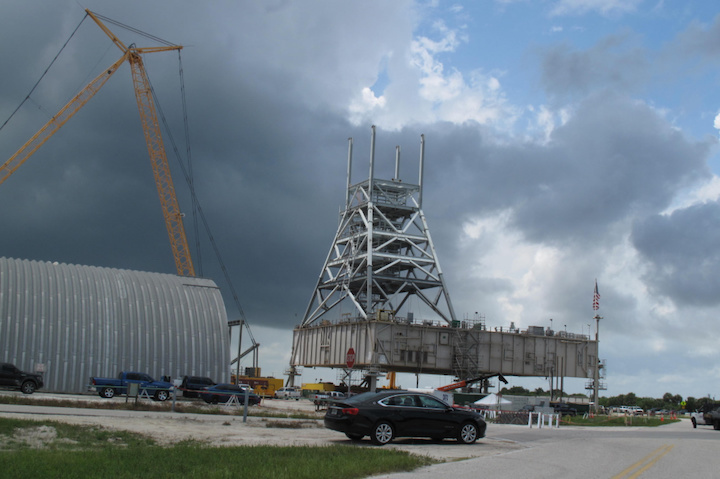13.09.2020

Following the cancellation of Northrop Grumman’s OmegA rocket, work to demolish the vehicle’s launch tower on a repurposed former Shuttle program Mobile Launch Platform (MLP) will mark the erasure of the program from the Kennedy Space Center (KSC). It was hoped OmegA would allow the “clean pad” at 39B to fall under the assigned mandate of a ‘Multi-User Spaceport’. Instead, 39B will now only see a maximum of one SLS launch per year.
OmegA’s short life ended when Northrop Grumman lost out on the National Security Space Launch award from the U.S. Space Force, which was split between ULA and SpaceX.
Although the company only admitted the vehicle was to be shelved this week, the program was ended within days of losing out on the award. The rocket’s demise was confirmed by a work stoppage relating to OmegA-related groundwork involving the use of a High Bay inside the Vehicle Assembly Building (VAB) and the tower on the MLP.
MLP-3 was a former Space Shuttle platform and was being repurposed to host OmegA launches via rollouts from the VAB’s High Bay-2 (HB2).
JP Donovan Construction is now about to begin work on removing the half-built tower structure on the MLP-3 Base. This work will be completed by November. It is not known what fate awaits the former Shuttle MLP.

The tower on MLP-3 – via L2
Although no modifications to HB2 had been conducted inside the VAB, it was being used to store OmegA related hardware, which will be removed before the end of September.
The cancellation of the program came soon after several inert OmegA segments were shipped to KSC on railcars, along with the segments for the Artemis-1 SLS launch.
Teams are set to coordinate with the SLS program to return the inert segments and railcars back to Utah with the empty Artemis I railcars.
The end of OmegA marks the third time a rocket with a solid first stage booster has failed to become operational. Ares I only managed one test flight with Ares 1-X before the end of the Constellation Program, and the Liberty Rocket was shelved early into development.
Notably, all three rockets were set to call KSC’s 39B as their launch pad. Liberty and OmegA were set to become commercial rockets, allowing for a fanfare from Kennedy officials about the long-term mantra of being a multi-use spaceport in the post-Shuttle era.
That ambition has been achieved with Space Florida brokering a lease of 39A between SpaceX and NASA, allowing for the phased conversion of the pad that hosted the final Shuttle launch (STS-135) into one capable of launching Falcon 9 and Falcon Heavy.
Adding a Horizontal Integration Facility (HIF) at the entrance to the ramp to 39A, SpaceX has since refurbished the Fixed Service Structure (FSS) and added a Crew Access Arm (CAA) to cater for launching crew missions.
SpaceX is also adding a Starship launch mount to the side of the ramp and will also build a Mobile Service Tower (MST) following their NSSL award, allowing for U.S. Space Force required vertical payload integration tasks.

Maxar Satellite photo of 39A ahead of Dragon DM-2 mission
Pad 39B was the first of the two former Shuttle pads to undergo modification, with three 600 foot Lightning Protection System towers built around the pad, while for the FSS and Rotating Service Structure (RSS) were demolished.
This allowed 39B to become a “clean pad” to be able to launch several different types of rockets that would roll to the pad on their Mobile Platforms. Essentially FSS’s would be carried to the pad via the Crawler Transporters and “plug into” 39Bs utilities.

SLS ML-1 rolls to 39B on a test run – via NASA
SLS is set to launch by the end of next year at the earliest, with the second mission following a couple of years later. It is likely that SLS’s launch rate will never exceed one launch per year.
This remains the situation despite NASA opting to build a second Mobile Launcher (ML-2) for the SLS Block 1B, to avoid a multi-year standdown to convert ML-1 to cater for the taller evolution of the Heavy Lift Vehicle (HLV).
Other options to gain additional suitors for KSC’s launch facilities included a small launcher facility inside 39B’s perimeter, strangely named 39C.
However, those plans were scrapped after the primary suitor, Rocket Lab, opted to set up a launch pad at Wallops. Additional small launcher companies also opted against launching from the facility, citing interest in dedicated facilities in Cape Canaveral.
The resulting decisions have diluted KSC’s multi-user spaceport into one that caters to SLS’s one launch per year and being host to SpaceX at the leased 39A.
Some relief may come from SLC-48, which KSC is looking to claim as its own per the recent addition of signage over the construction site.

Pad 48 – photo via L2
This pad could become what KSC had initially envisioned for 39C, with LC-48’s construction catering for a multi-user launch site for small launchers and spacecraft. It is located south of 39A and north of SLC-41.
To cater to various customers, it is being constructed as a clean pad to support multiple launch systems with differing propellant needs.
While the loss of OmegA will hit KSC hard, the prospect of announcing multiple launch providers at KSC’s LC-48 will boost the center’s “multi-user spaceport” ambitions.
Quelle: NS
